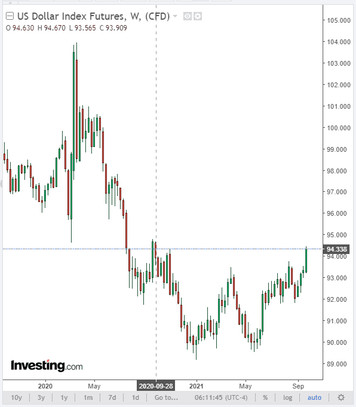Last Wednesday, the Energy Information Administration (EIA) of the US Department of Energy announced an increase in oil reserves in US storage facilities in the week of September 18-24 by 4.6 million barrels, which turned out to be higher than the forecasts, which assumed a decrease in reserves by 4.5 million barrels. The EIA also announced an increase in gasoline stocks by 200,000 barrels and distillate stocks by 400,000 barrels. On the eve, on Tuesday, the American Petroleum Institute also announced an increase in oil reserves by 4.1 million barrels. In the previous seven weeks, the EIA reported a drop in oil reserves. The released data from the US Department of Energy showed that the consequences of hurricane Ida, which came to the Gulf of Mexico a month ago, are coming to naught, and the volume of US oil reserves is 418.5 million barrels, which is about 7% below the average 5-year value for this time of the year.
Oil futures fell in price after the publication of the US Department of Energy data, but closed yesterday's trading day in positive territory. In the first half of today's trading day, they traded mostly in a range, maintaining positive dynamics and an inclination to further growth, despite the strong strengthening of the dollar in recent weeks.
As of this writing, WTI crude oil futures are traded near 74.53, at the level of yesterday's close. On Tuesday, the price briefly exceeded a 35-month high, reaching $ 76.50 a barrel.
A meeting of the OPEC coalition is scheduled for Monday. This oil cartel is likely to continue to increase production by 400,000 barrels per day, as previously planned, despite the rise in oil prices, although more drastic measures to increase production are not ruled out due to oil shortages and rising prices. In July, OPEC+ agreed to increase production by 400,000 barrels per day per month starting in August and plans to gradually ease production restrictions imposed last year amid weak demand amid quarantine measures.
If OPEC+ decides to further increase production volumes, then this decision will have a negative impact on oil prices in the short term. In the meantime, the oil market has developed bullish drivers and fundamental factors that contribute to the growth of prices and demand for oil and oil products, while quarantine measures introduced in connection with the spread of the delta strain are gradually being canceled in various countries, and oil reserves are limited.
Meanwhile, the dollar continues to strengthen. Today, the DXY dollar index is growing for the 4th week in a row. At the time of publication of this article, the DXY index, which reflects the value of the dollar against a basket of 6 major currencies, is near the level of 94.34, i.e. near the highs of this year and the level corresponding to the end of September 2020.

On Wednesday, US Federal Reserve Chairman Jerome Powell, during a discussion hosted by the European Central Bank, said that recent high inflation may last longer than central bank officials expected, although he still sees the rise in inflation as temporary.
Powell signaled last week that the central bank was ready to begin winding down stimulus programs in November, and Fed officials indicated they could raise interest rates next year amid risks of a more sustained-than-expected rise in inflation. If the economy does not show significant weakness, the Fed will officially announce a phased cut in monthly purchases of $ 120 billion in Treasury and mortgage-backed securities at its next meeting on November 2-3.
Thus, the upward dynamics of the dollar is fueled by expectations of the imminent start of curtailing the stimulus program of the Fed, while strong macro data continues to come from the US.
A more confident rise in the dollar at the moment is hampered only by uncertainty over the threshold of public debt in the United States, economists say, but this is a short-term obstacle. Most likely, the national debt threshold will be raised again.
Fresh macro data from the US will be released today (at 12:30 GMT). It is expected that the number of initial applications for unemployment benefits in the United States in the week to September 24 fell to 335 thousand from 351 thousand a week earlier, which is a positive factor for the dollar.
Also, according to the final release of the Bureau of Economic Analysis, GDP in the 2nd quarter grew by +6.6%, which is below the preliminary forecast of +8.2%.
If the data turns out to be even weaker, then the dollar will be under pressure. Positive GDP data will support the dollar.
According to the forecast of the IHS Markit company, presented at the end of September, the US GDP in the third quarter could grow by +3.6% on an annualized basis (in mid-July, the company assumed that the country's economy in the third quarter would grow by 7.8%). The downward revision of the forecast is partly due to weakening consumer spending amid the spread of the delta strain. Taking control of the delta strain of coronavirus “is still the most important economic challenge”, Powell said on Wednesday. Consumer spending is the main engine of growth in the US economy.
Powell will speak to the US Congress today (14:00 GMT) on the topic of economics and monetary policy. Powell will likely repeat in his report the statements he made last week at a press conference when the central bank signaled its intention to begin revising its soft monetary policy at a meeting scheduled for November 2-3. Investors again believed in the intentions of the FRS leadership to start curtailing the stimulating policy. Most likely, Powell will not disappoint investors on this issue.





